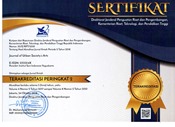Education Park Concept on Green Open Space Planning through Historical and Cultural Approach
Abstract
Green Open Space Planning (RTH) for urban areas needs to support ecological functions, education facilities, and social interaction facilities for urban communities and regional identity. As green open spaces, Complex Elementary Park and Reading Park in Palopo, South Sulawesi have not yet fulfilled their functions and benefits optimally. The two parks that are located in the heritage area become a unique/distinctive potential to show the historical connotation of the location in its design. This study aims to provide landscape design recommendations by exploring the potential of the location through the historical and cultural approach of the Luwu Kingdom. The research was conducted using a descriptive qualitative method that refers to the landscape planning of Seymour M. Gold through the stages of preparation, inventory, analysis, synthesis, and planning. The results of this study resulted in an Education Park site plan that elaborated the physical and philosophical characteristic of three cultural heritages, namely the Datu Luwu Palace Complex, the Jami' Mosque, and the Post and Giro Office.
Konsep Taman Edukasi pada Perencanaan Ruang Terbuka Hijau melalui Pendekatan Sejarah dan Budaya. Perencanaan Ruang Terbuka Hijau (RTH) Kawasan Perkotaan perlu menunjang fungsi ekologis, wadah pendidikan, sarana interaksi sosial masyarakat urban dan identitas daerah. Sebagai RTH, Taman SD Kompleks dan Taman Baca di kota Palopo, Sulawesi Selatan belum menunjukkan terpenuhinya fungsi dan manfaatnya secara optimal. Kedua taman yang berada dalam kawasan heritage menjadi potensi khas/unik untuk menunjukkan historical connotation lokasi dalam desainnya. Penelitian ini bertujuan membuat rekomendasi desain lanskap dengan mengeksplorasi potensi lokasi melalui pendekatan sejarah dan budaya Kerajaan Luwu. Penelitian dilakukan menggunakan metode kualitatif deskriptif yang mengacu pada perencanaan lanskap Seymour M. Gold melalui tahapan persiapan, inventarisasi, analisis, sintesis dan perencanaan. Hasil penelitian ini menghasilkan siteplan Taman Edukasi yang mengelaborasi karakter fisik dan filosofis tiga cagar budaya yaitu Kompleks Istana Datu Luwu, Masjid Jami’ dan Kantor Pos dan Giro.
Keywords
Full Text:
PDFReferences
Journal Articles
Alabi, MO (2022). Encroachment on Green Open Space, its Implications on Health and Socio-Economy in Akure, Nigeria. Cities and Health , 6 (1), 123–135.
Aronson, MF, Lepczyk, CA, Evans, KL, Goddard, MA, Lerman, SB, MacIvor, JS, … Vargo, T. (2017). Biodiversity in the City: Key Challenges for Urban Green Space Management. Frontiers in Ecology and The Environment , 15 (4), 189–196.
Aswan risk. (2020). Analysis of the Form, Meaning and Philosophical Values in the Logo Design of the XL Kedatuan Luwu. Ultimart: Journal of Visual Communication , 13 (1), 1–8.
Barghi, R., Zakaria, Z., Hamzah, A., & Hashim, NH (2017). Heritage Education in the Primary School Standard Curriculum of Malaysia. Teaching and Teacher Education , 61 , 124–131.
Basoglu, UD (2018). The Importance of Physical Literacy for Physical Education and Recreation. Journal of Education and Training Studies , 6 (4), 139–142.
Cirino, DW, Tambosi, LR, Mauad, T., Freitas, SR de, & Metzger, JP (2022). Balanced Spatial Distribution of Green Areas Creates Healthier Urban Landscapes. Journal of Applied Ecology , 59 (7), 1884–1896.
Douglas, O., Russell, P., & Scott, M. (2019). Positive Perceptions of Green and Open Space as Predictors of Neighborhood Quality of Life: Implications for Urban Planning Across The City Region. Journal of Environmental Planning and Management , 62 (4), 626–646.
Duivenvoorden, E., Hartmann, T., Brinkhuijsen, M., & Hesselmans, T. (2021). Managing Public Space – A Blind Spot of Urban Planning and Design. Cities , 109 , 1–3.
Dyga, PM, & Wistoftb, K. (2018). Wellbeing in School Gardens – the Case of the Gardens for Bellies Food and Environmental Education Program. Environmental Education Research , 24 (8), 1177–1191.
Fajarini, U. (2014). The Role of Local Wisdom in Character Education. Socio Didactics: Social Science Education Journal , 1 (2), 123–130.
Filazzola, A., Shrestha, N., & MacIvor, JS (2019). The Contribution of Constructed Green Infrastructure to Urban Biodiversity: A Synthesis and Meta‐Analysis. Journal of Applied Ecology , 56 (9), 2131–2143.
Green, M., & Rayner, M. (2020). School Ground Pedagogies for Enriching Children's Outdoor Learning. International Journal of Primary, Elementary and Early Years Education , 50 (2), 238–251.
Harjanti, AD, Purwani, O., & Iswati, TY (2017). Boyolali Botanical Garden with a Fun Design Approach as a Botanical Educational Tourism Center. Region: Journal of Regional Development And Participatory Planning , 12 (2), 143–158.
Heather E Prince. (2018). Changes in Outdoor learning in Primary Schools in England, 1995 and 2017: Lessons for Good Practice. Journal of Adventure Education and Outdoor Learning , 19 (4), 329–342.
M, V. den B., M, VP, I, VK, S, A., B, B., M, C., … Nieuwenhuijsen. (2016). Visiting Green Space is Associated with Mental Health and Vitality: A Cross-Sectional Study in Four European Cities. Health & Place , 38 , 8–15.
Mahendra, NP, & Santoso, I. (2018). Facilities for Science Education Park in Kediri. Journal of Architectural Edimensions , VI (1), 329_336.
Martin, D., & Endangsih, T. (2018). Designing an Educational Park with a High Tech Approach in South Kembangan, West Jakarta. Journal of the Maestro , 1 (2), 92–100.
Munadia, N. (2022). Planning for a Floating Tourism Park Based on Environmental Education. Sensistek ; Marine Science And Technology Research , 5 (1), 18–21.
Khan, M., McGeown, SP, & Islam, MZ (2019). There is No Better Way to Study Science than Collect and Analyze Data in Your Own Yard ; Outdoor Classroom and Primary School Children in Bangladesh. Children's Geographies , 17 (2), 217–230.
Marianto, MD (2020). EcoArt Through Various Approaches. Journal of the Urban Society's Arts , 7 (1), 21–29.
Mungmachon, MR (2012). Knowledge and Local Wisdom: Community Treasure. International Journal of Humanities and Social Science , 2 (13), 174–181.
Muntazori, AF (2013). The Eight Star Symbol as the Identity of the Muslim Community ; Semiotics Study on the Eight Star Symbol. Deixis , 5 (1), 58–80.
Nurmalinda. (2021). Symbolic Interactionism in Ceremonies of Ritual Medicine in Malay Society in Riau Province. Journal of Urban Society's Art , 8 (2), 98–110.
Nordgren, K. (2016). How to do Things With History: Use of History as a Link Between Historical Consciousness and Historical Culture. Theory & Research in Social Education , 44 (4), 479–504.
Pesurnay, AJ (2018). Local Wisdom in a New Paradigm: Applying System Theory to the Study of Local Culture in Indonesia. IOP Conference Series: Earth and Environmental Science , 175 (1), 1–8.
Pinto, H., & Ibañez-Etxeberria, A. (2018). Constructing Historical Thinking and Inclusive Identities: Analysis of Heritage Education Activities. History Education Research Journal , 15 (2), 342–354.
Reiza D. Dienaputra. (2012). Art History Reconstruction in Visual History Constructs. Stage : Journal of Cultural Arts , 22 (4), 1–16.
Riechers, M., Barkmann, J., & Tscharntke, T. (2016). Perceptions of Cultural Ecosystem Services from Urban Green. Ecosystem Services , 17 , 33–39.
Setyabudi, I., Nuraini, N., Alfian, R., & Nailufar, B. (2017). The Concept of Educational Parks in Elementary Schools in Malang City (Case Study: SDN Lowokwaru 3 Malang). Review of Urbanism and Architectural Studies , 15 (1), 23–34. https://doi.org/10.21776/ub.ruas.2017.015.01.3
Sibarani, R. (2018). The Role of Local Wisdom in Developing Friendly City. IOP Conf. Series: Earth and Environmental Science , 126 (1), 1–6.
Taylor, N., Wright, J., & O'Flynn, G. (2021). Cultivating “Health” in the School Garden. Sport, Education and Society , 26 (4), 403–416.
Tonia Gray. (2019). Outdoor Learning and Psychological Resilience: Making Today's Students Better Prepared for Tomorrow's World. Curriculum Perspectives , 39 (1), 67–72.
Truong, S., Singh, M., Reid, C., Gray, T., & Ward, K. (2018). Vertical Schooling and Learning Transformations in Curriculum Research: Points and Counterpoints in Outdoor Education and Sustainability. Curriculum Perspectives , 38 (2), 181–186.
Wati, T., & Fatkhuroyan. (2017). Analysis of Comfort Level in DKI Jakarta Based on THI Index (Temperature Humidity Index). Journal of Environmental Science , 15 (1), 57–63.
Zakharova, OV, Suvorova, LG, Bogdanova, MV, Zakharov, AV, Permyakov, A., & Malykh, IY (2021). Environmental Education: Ecological Wisdom of Indigenous Peoples in Western Siberia. Sustainability , 13 (7), 1–18.
Sibarani, R. (2018). The Role of Local Wisdom in Developing Friendly City. IOP Conf. Series: Earth and Environmental Science , 126 (1), 1–6.
Book
Almusaed, A. (2018). Landscape Architecture- The Sense of Place, Models and Applications . London: IntechOpen.
Chen, G. (2009). Planting Design Illustrated . Denver: Outskirts Press Inc.
Desmond, D., Grieshop, J., & Subramaniam, A. (2004). Revisiting Garden Based Learning in Basic Education ; Philosophical Roots, Historical Foundations, Best Practices and Products, Impacts, Outcomes, and Future Directions . California: University of California Press.
Frick, Heinz, & Tri Hesti Mulyani. (2006). Ecological Architecture . Yogyakarta: Kanisius.
Gold, SM (1980). Recreation Planning and Design . New York: McGraw-Hill Book Co.
Hakim, R. (1987). Design Elements in Landscape Architecture . Jakarta: Literacy Development.
Hamidah, N. (2022). City Architecture, City Design and Green Open Space . Yogyakarta: Depublish.
Heriyati, P., & Kurniatun, TC (2021). Empowerment of Child-Friendly Integrated Public Spaces as a Potential Development of Residents' Small Businesses . Pasuruan: CV. Publisher Qiara Media.
Pattisinai, AR, & Widayanti, FR (2020). Landscape and Street Lighting . Malang: Nusa Creative Media.
Rahmawati. (2020). Corporate Social Responsibility Based on Local Wisdom (Perspective Kedatuan Luwu) . Unfortunate: Thirsty.
Productive Landscape Development Research Team for Greening the City of Yogyakarta. (2021). Urban Productive Landscapes . Yogyakarta: CV. ANDI OFFSET.
Potpourri
Milliken, S. (2018). Ecosystem Services in Urban Environments. In Nature Based Strategies for Urban and Building Sustainability . Elsevier.
Thesis, thesis
Angraeni, I. (2018). The Symbolic Form and Meaning of the Langkanae Luwu Traditional House in Palopo City . Makassar public university.
Siddiq, S. (2016). Palopo Mayor's Office Redesign . UIN Alauddin, Makassar.
Surur, F. (2013). Structuring and Preserving the Historical Area of Palopo City as an Indonesian Heritage City . Bogor Agricultural Institute.
Website
Asrul. (2019). The Palopo Agriculture Office Plants Luwu Raya Endemic Trees in the Tinjomuyo Forest, Semarang. Retrieved from sulselsatu.com website: https://www.sulselsatu.com/2019/07/04/sulsel/luwu-raya/dinas-pertanian-palopo-tanam-tree-endemic-luwu-raya-di-hutan-tinjomuyo-semarang.html
horti. (2018). Profile of Jasmine Agribusiness in Indonesia. Retrieved from the Directorate General of Horticulture website: http://hortikultura.pertanian.go.id/?p=2404
Proceedings
Desiana, V., & Khan, RI (2022). The Importance of Gross Motor Skills for Early Childhood and Optimizing Strategies through Traditional Games. Strategies for Dealing with the Post-Covid-19 Pandemic Education System for a Superior and Resilient Generation of Indonesia , 649–657. Kediri.
DOI: https://doi.org/10.24821/jousa.v9i2.8088
Refbacks
- There are currently no refbacks.

This work is licensed under a Creative Commons Attribution 4.0 International License. ISSN 2355-2131 (print) | ISSN 2355-214X (online).







